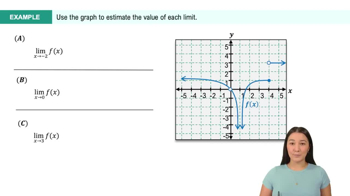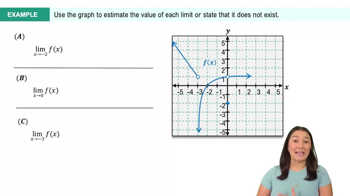Table of contents
- 0. Functions7h 52m
- Introduction to Functions16m
- Piecewise Functions10m
- Properties of Functions9m
- Common Functions1h 8m
- Transformations5m
- Combining Functions27m
- Exponent rules32m
- Exponential Functions28m
- Logarithmic Functions24m
- Properties of Logarithms34m
- Exponential & Logarithmic Equations35m
- Introduction to Trigonometric Functions38m
- Graphs of Trigonometric Functions44m
- Trigonometric Identities47m
- Inverse Trigonometric Functions48m
- 1. Limits and Continuity2h 2m
- 2. Intro to Derivatives1h 33m
- 3. Techniques of Differentiation3h 18m
- 4. Applications of Derivatives2h 38m
- 5. Graphical Applications of Derivatives6h 2m
- 6. Derivatives of Inverse, Exponential, & Logarithmic Functions2h 37m
- 7. Antiderivatives & Indefinite Integrals1h 26m
1. Limits and Continuity
Introduction to Limits
Problem 12b
Textbook Question
Given the function f(x)=−16x2+64x, complete the following. <IMAGE>
Make a conjecture about the value of the limit of the slopes of the secant lines that pass through (x,f(x)) and (2,f(2)) as x approaches 2.
 Verified step by step guidance
Verified step by step guidance1
First, understand that the slope of the secant line between two points (x, f(x)) and (2, f(2)) on the curve is given by the difference quotient: \( m_{sec} = \frac{f(x) - f(2)}{x - 2} \).
Calculate \( f(2) \) by substituting \( x = 2 \) into the function \( f(x) = -16x^2 + 64x \). This will give you the y-coordinate of the point (2, f(2)).
Substitute \( f(x) = -16x^2 + 64x \) and \( f(2) \) into the difference quotient formula: \( m_{sec} = \frac{-16x^2 + 64x - f(2)}{x - 2} \).
Simplify the expression for \( m_{sec} \) by performing polynomial division or factoring, if possible, to eliminate the \( x - 2 \) in the denominator.
Finally, make a conjecture about the limit of \( m_{sec} \) as \( x \) approaches 2. This involves evaluating the simplified expression for \( m_{sec} \) as \( x \to 2 \), which will give you the slope of the tangent line at \( x = 2 \).
Recommended similar problem, with video answer:
 Verified Solution
Verified SolutionThis video solution was recommended by our tutors as helpful for the problem above
Video duration:
8mPlay a video:
Was this helpful?

 6:47m
6:47mWatch next
Master Finding Limits Numerically and Graphically with a bite sized video explanation from Callie
Start learning





